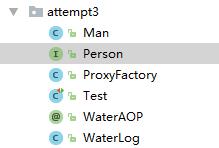模仿spring-aop的功能,利用注解搭建自己的框架。
Posted 勿忘初心-Lislie杰
tags:
篇首语:本文由小常识网(cha138.com)小编为大家整理,主要介绍了模仿spring-aop的功能,利用注解搭建自己的框架。相关的知识,希望对你有一定的参考价值。
入JAVA坑7月有余,也尝试自己手动搭建框架,最近对spring aop的这种切面很着迷,为此记录下自己目前搭出来的小小的demo,后续有时间也会继续改进自己的demo。望大神们不吝赐教。
主要还是运用反射和java自带的代理类。理论知识就不说了,因为我目前也不是很清楚,避免误导,还是避而不谈吧。好了,直接根据代码撸吧。
结构:

接口
Person.java
public interface Person {
void say();
}
接口实现类
Man.java
public class Man implements Person {
@Override
public void say() {
System.out.println("男人say:....");
}
}
自定义注解
@interface WaterAOP
@Retention(RetentionPolicy.RUNTIME)
@Target({ElementType.PARAMETER, ElementType.METHOD})
@Documented
public @interface WaterAOP {
enum METHOD{before,after,afterthrowing}
METHOD method() default METHOD.after;
String Name() default "类全名";
}
自定义注解类
WaterLog.java
public class WaterLog {
@WaterAOP(Name = "com.water.aop.attempt3.Man",method = WaterAOP.METHOD.after)
public void afterAction(){
System.out.println("后置行为");
}
@WaterAOP(Name = "com.water.aop.attempt3.Man",method = WaterAOP.METHOD.before)
public void beforeAction(){
System.out.println("前置行为");
}
}
实现自定义代理类(就是在
Proxy.newProxyInstance()方法的第三个参数里做手脚。用了java8的lambda表达式。
)
ProxyFactory.java
public class ProxyFactory {
// 维持一个实现接口的被代理的对象,后面改为对象组,由浅入深
private Person person;
private WaterLog waterLog;
private Method beforeMethod=null,afterMethod=null;
public ProxyFactory(Person person,WaterLog waterLog){
this.person=person;
this.waterLog=waterLog;
}
public Object getProxyInstance(){
return Proxy.newProxyInstance(
person.getClass().getClassLoader(),
person.getClass().getInterfaces(),
// 第一个参数就是代理者,如果你想对代理者做一些操作可以使用这个参数;
// 第二个就是被执行的方法,
// 第三个是执行该方法所需的参数。
(Object proxyObj, Method method,Object[] args)->{
//如果没有传入aop 直接返回空
if(waterLog==null){
return null;
}
Class aop=waterLog.getClass();
Class c = person.getClass();
// 获取aop类的方法的注解并赋给自定义的一些变量,下面根据这些变量是否有值来确定是否有注解
getAnnotation(aop,c);
if(beforeMethod!=null){
beforeMethod.invoke(waterLog);
}
// 代理对象执行方法并且获得返回值
Object returnValue=method.invoke(person,args);
if(afterMethod!=null){
afterMethod.invoke(waterLog);
}
return returnValue;
}
);
}
private void getAnnotation(Class aop,Class proxy){
//如果有AOP的类
if(waterLog!=null){
// 获取切面类所有的方法
Method[] methodsAOP=aop.getMethods();
// 如果切入的日志类的方法不为空
if(methodsAOP!=null){
for(Method logMethod:methodsAOP){
// 取得WaterLog类的方法上WaterAOP注解
WaterAOP waterAOP=logMethod.getAnnotation(WaterAOP.class);
if(waterAOP!=null) {
// 如果AOP上的注解与传入的类名一致
if (proxy.toString().substring(6).equals(waterAOP.Name())) {
if (waterAOP.method() == WaterAOP.METHOD.before) {
// 赋值 ,后面再执行
beforeMethod=logMethod;
}else if(waterAOP.method() == WaterAOP.METHOD.after){
afterMethod=logMethod;
}
}
}
}
}
}
}
}
zhuanzi https://www.cnblogs.com/water-zmh/p/8427877.html
测试类
Test.java (junit是个测试包,也可以直接用main方法)
public class Test {
@org.junit.Test
public void waterAOP(){
Person person=new Man();
Person proxyPerson=(Person) new ProxyFactory(person,new WaterLog()).getProxyInstance();
proxyPerson.say();
}
}
大致的流程就是:传入要被代理的类和自定义的注解类,运用反射获取注解类里方法上的注解属性的值,然后进行比对,再进行相应的操作。
以上是关于模仿spring-aop的功能,利用注解搭建自己的框架。的主要内容,如果未能解决你的问题,请参考以下文章
